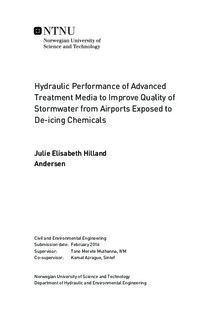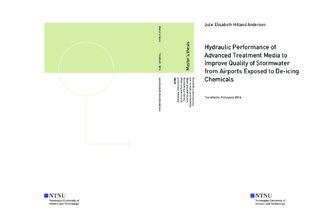| dc.description.abstract | Winter-runoff from airports contains a high fraction of contaminated stormwater. Contaminants such as de-icing chemicals propylene glycol and potassium formate, heavy metals and PAHs are often present in stormwater runoff from airports and contribute to pollution of groundwater and surface water. Installing granular filters along the runway, can be seen as an alternative solution to remove contaminants by means of physical processes such as filtration, adsorption and by biodegradation.
As a part of the project Klima 2050, the hydraulic performance of five different filter media, consisting of fine, coarse and mixed Filtralite materials provided by Weber Saint-Gobain and activated carbon, was tested for treatment of stormwater. The synthetical stormwater used in the tests represented the first flush of winter-runoff from airports exposed to de-icing chemicals and contained sediments and de-icing chemicals from Værnes Airport in Trondheim, provided by Avinor. A column study consisting of four series of tests; with two different flows and two different concentrations of de-icing chemicals, was conducted to investigate the hydraulic performance of the different filter media in varying conditions and the removal of turbidity, suspended solids, de-icing chemicals and heavy metals.
The results showed that the hydraulic performance of the different filter media varied depending on the type of media used and the conditions tested. Whereas the experiments with high flow lasted only one day before the filters were clogged, the experiments with low flow lasted 5-7 days before clogging. All filter media provided good removal, between 93.8 % and 99.6 %, of particles by size exclusion, while adsorption (with removal of between approximately 10 % and 40 % of de-icing chemicals) only was observed in the filter media with an activated carbon layer. Biodegradation, causing removal up to 88 %, of de-icing chemicals was observed for the longer lasting tests, and started approximately after two days of operation. The hydraulic performance, treatment abilities and maintenance demands of the filter media were compared, and the recommended filter medium of the media tested was the fine material, Filtralite NC 0-2, with activated carbon layer.
Over all, the tested filter media showed acceptable hydraulic performance, both in terms of suspended solids removed and operation time before clogging. All filters, with two exeptions, removed more than 1.2 kg/m2 suspended solids per surface area before clogging. Removal of de-icing chemicals was good when biodegradation occurred in the test with low concentrations of de-icing chemicals, but toxicity seemed to prevent growth of biomass for high concentrations of de-icing chemicals. | |

